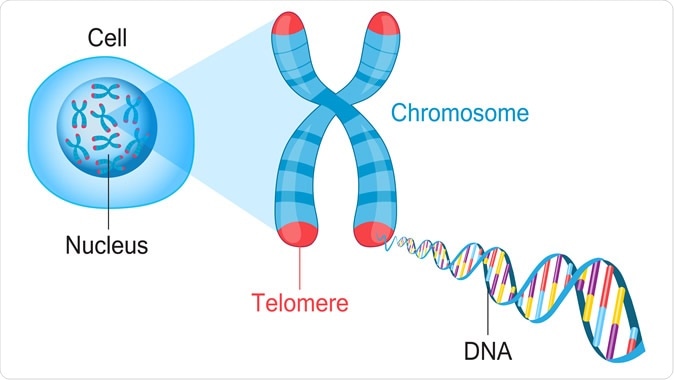Aging is associated with multiple disease conditions. Recently it has been found that many of these illnesses are linked to the length of the telomeres at the ends of every chromosome. Telomere length (TL) is affected by both genetic and epigenetic contributions. A new study found that one type of epigenetic change called DNA methylation is closely linked to TL. The study by researchers at the University of California Los Angeles shows a very significant linkage between two different markers that indicate aging.
What are telomeres?
Telomeres are repeating sequences of TTAGGG that tag the ends of all chromosomes. They are designed to prevent unpredictable changes in the DNA strand, keeping the genome stable. In actively dividing cells, such as those in the bone marrow, the stem cells of the embryo, and germ cells in the adult, telomere length (TL) is kept constant by the enzyme telomerase. As the organism grows, this enzyme becomes less active over time. This leads to a slow decrease in telomere length, until a point is reached at which the cell is no longer capable of replication (‘replicative senescence’).

Telomeres are protective caps on the end of chromosomes. Cell, chromosome and DNA vector illustration. Credit: Fancy Tapis / Shutterstock
Telomeres are generally equal in length in men and women, and reported differences may be due to the measurement method used. The length is affected by race, with Europeans having shorter TL than Africans. The exact length of these tags varies, and is a trait transmitted from generation to generation. However, is also vulnerable to change by epigenetic modifications.
Specifically, leukocyte telomere length (LTL) is weakly but still significantly correlated to two chronic diseases that primarily affect aging human beings – cardiovascular disease (CVD) and cancer. The longer the telomere, the higher is the risk of some cancers.
Up to 82% of the LTL is determined by genetic factors, depending on the method used. Previous LTL studies using a tool called genome-wide association studies (GWAS) identified 11 genes linked to this trait. However, many aspects of the differences seen in LTL are not explained by these genes.
Another factor that alters LTL is epigenetic modification, that is, changes in the way a cell functions or genes are expressed that do not involve any change in the DNA sequence, but by methylation, for instance. A study of DNA methylation (DNAm) on the whole epigenome is an excellent way to detect the different patterns that accompany various phenotypes. The current study is the largest ever epigenome-wide association study (EWAS) to find links with DNAm. Here, seven groups were used from different studies like the Framingham Heart Study, the Jackson Heart Study, and the Womens’ Health Initiative.
What did the study show?
The researchers found that in all groups, defined by sex and ethnic origin, DNAm was associated with LTL. There were 823 CpG regions that showed a significant correlation with LTL. Among these, 88% showed a negative association with higher levels of DNAm corresponding to shorter LTLs.
The most common ten CpGs among the 823 were associated with seven genes, which are known to encode many vital processes such as early brain development, protein synthesis, intracellular membrane transport and tumor suppressor activity.
These associations were found near areas that contained genes which regulated important body processes like blood clotting, wound healing and wound responses. This agrees to previous studies that show that telomerase enzyme expression is a circadian process. Impaired circadian rhythm accompanies senescence of the cell, of which TL is a marker. Shortened telomeres also correlate with sleep disorders and shortened sleep duration.
TL is also linked to wound healing, with higher wound healing rates associated with increased telomere length. In a rabbit experiment, insertion of the human TERT gene boosted wound healing in aged rabbits. The patterns of association are quite distinct in African-American women compared to other groups: males of African origin, males of European origin, and females of European origin. The researchers say, “We identified over 800 genome-wide significant Cp G sites that are located in or near genes with links to circadian rhythm, blood coagulation and wound healing. These findings link two hallmarks of aging: epigenetic changes and telomere biology.”
The study was published in the journal Aging on August 26, 2019.
Journal reference:
Epigenome-wide association study of leukocyte telomere length. Yunsung Lee 1, Dianjianyi Sun, Anil P.S. Ori, Ake T. Lu, Anne Seeboth, Sarah E. Harris, Ian J. Deary, Riccardo E. Marioni, Mette Soerensen, Jonas Mengel-From, Jacob Hjelmborg, Kaare Christensen, James G. Wilson, Daniel Levy, Alex P. Reiner, Wei Chen, Shengxu Li, Jennifer R. Harris, Per Magnus, Abraham Aviv, Astanand Jugessur, and Steve Horvath. Aging. Volume 11, Issue 16 pp 5876—5894. https://doi.org/10.18632/aging.102230. https://www.aging-us.com/article/102230/text